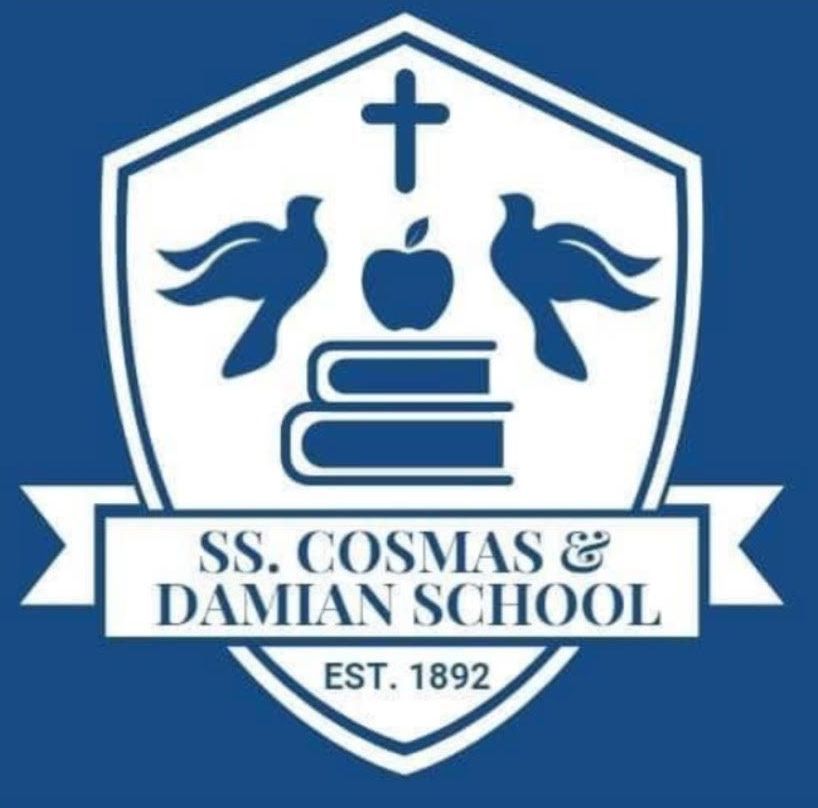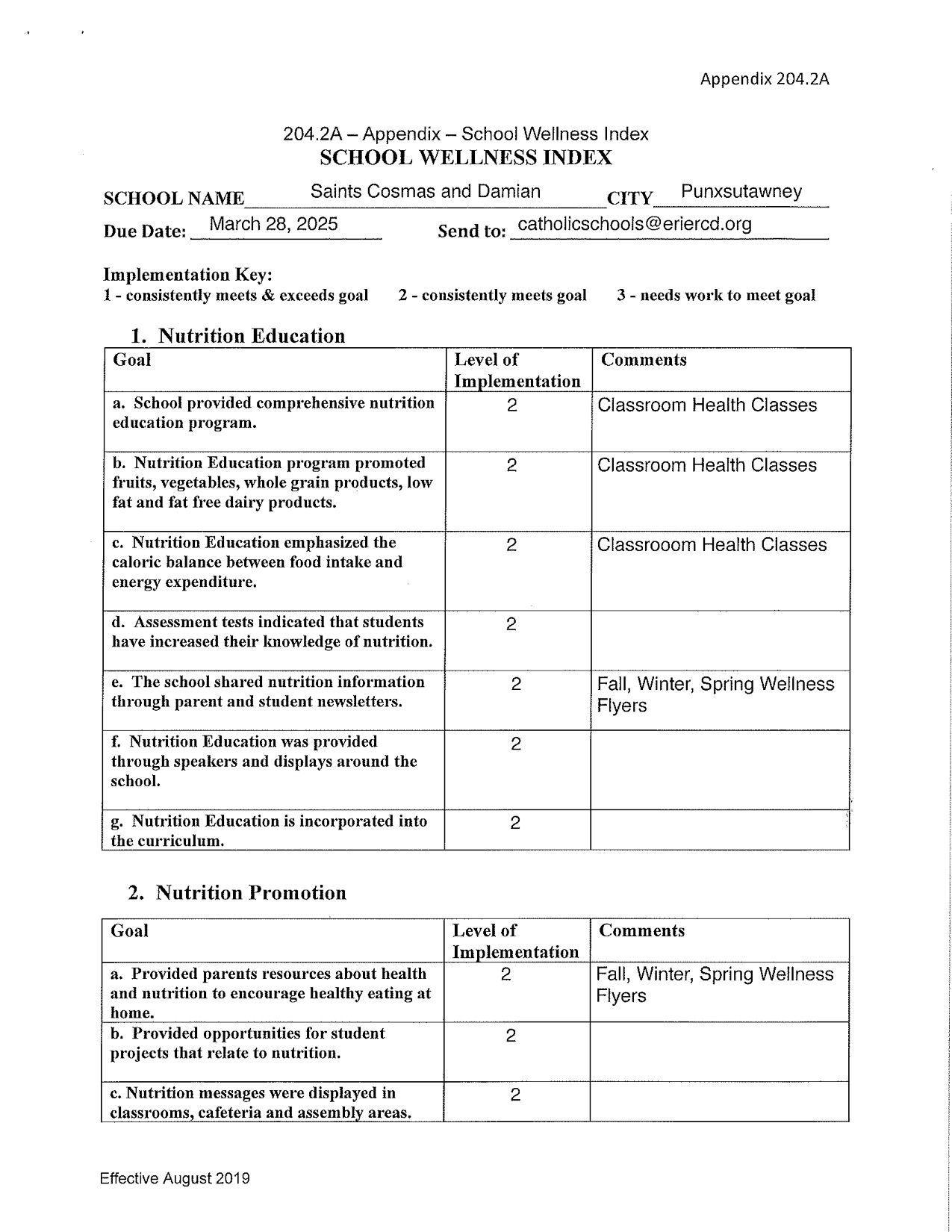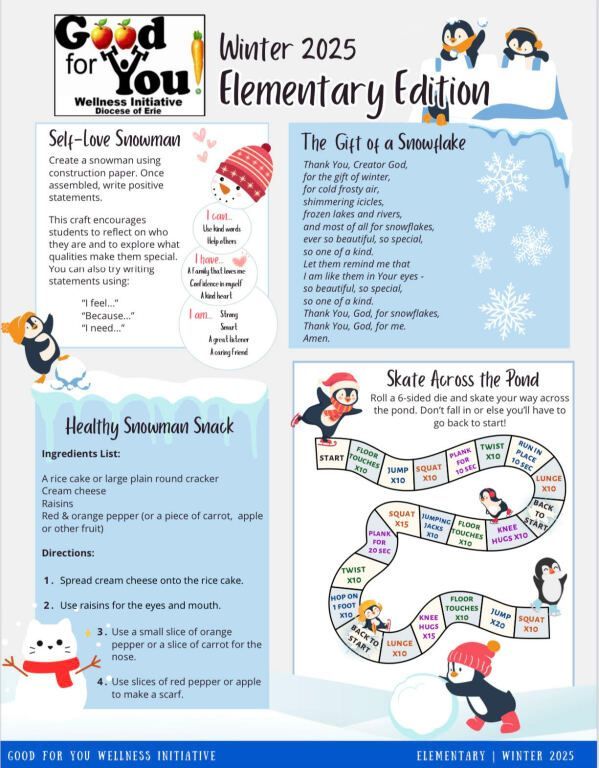Health And Wellness Resources
Diocese of Erie WELLNESS Policy #204.2
August 2019 Revised: March 2024
204.2 – WELLNESS
Purpose: (For schools participating in the National School Lunch Program) To provide students with a healthy school environment that maximizes individual growth and development.
Additional Authority:
WIC Reauthorization Act of 2004 Healthy, Hunger-free Kids Act of 2010
A. Definition
Competitive foods are defined as foods and beverages offered or sold to students on school campus during the school day, which are not part of the reimbursable school breakfast or lunch.
School campus means any area of property under the jurisdiction of the school that students may access during the school day.
School day means the period from midnight before school begins until thirty (30) minutes after the end of the official school day.
B. Requirements
The Wellness Policy has well-defined measurable goals:
- Engage students, parents, teachers, food service professionals, health professionals, and
- other community members in developing, implementing, and monitoring diocesan-wide
- nutrition and physical activity policies.
- Maximize nutritional and physical education to foster lifelong habits of healthy eating
- and physical activity that promote overall health and well-being.
- The Wellness Policy also includes:
- Periodic assessment tools to gauge how effectively student needs are being addressed
- Periodic updates to keep the policy current
- Feedback opportunities for all policy stakeholders.
- The Diocesan Wellness Policy is available for the public to view via the Catholic Schools Office website at the link for Parent Resources.
- The Diocesan Wellness Committee (DWC) will serve as a resource to schools for implementing the Wellness Policy. This committee will consist of parents, students, school food authorities, school administrators, physical education teachers, and school health professionals.
- Each school administrator will appoint a committee to oversee the implementation of the Student Wellness Policy in the school. This committee will be referred to as the Local Wellness Committee (LWC). The job of the LWC is to use the School Wellness Index to identify areas for development in the school.
Effective August 2024 96
Diocese of Erie WELLNESS Policy #204.2 August 2019 Revised: March 2024
School Wellness Index
The School Wellness Index is an assessment tool. (Appendix 204.2A) Periodic use of the School Wellness Index helps schools determine if they are meeting the goals of the Student Wellness Policy.
The School Wellness Index is divided into four (4) categories with goal statements relating to each of the four categories. The four areas included in the School Wellness Index are Nutrition Education, Physical Activity, School Meals and Competitive Foods. The use of an implementation key indicates the level of compliance with the stated goal.
The Implementation Key is as follows:
- Consistently meets and exceeds goal
- Consistently meets goal
- Needs work to meet goal.
Areas that contain “3” indicate a need for extra attention by the Local Wellness Committee to comply with the Student Wellness Policy and maximum health benefits for all students.
Based on the results of the School Wellness Index, the LWC will identify two or three goals that the school will address during the academic year. The LWC will provide periodic feedback to the administration, faculty, staff, students, and parents using newsletters (hard copy or electronic), parent broadcast announcements, and/or periodic meetings.
Nutrition Education Overview and Goals
Nutrition Education includes any learning experience designed to facilitate the voluntary adoption of food and drink choices and other nutrition-related behaviors conducive to health and well-being.
The primary goal of the Nutrition Education component is to influence students’ food and drink selections. Additionally, Nutrition Education will reinforce lifelong balance by emphasizing the link between caloric intake and exercise in ways that are appropriate.
Nutrition Education at all levels will:
- Be offered as part of an integrated curriculum
- Be sequential, comprehensive and standards based
- Be designed to provide students with the knowledge and skills necessary to improve and
- maintain a healthy lifestyle
- Include developmentally appropriate events that promote good nutritional habits
- Promote fruits, vegetables, whole grain products, low fat and fat free dairy products,
- and healthy food preparation methods.
- Nutrition Promotion Overview and Goals
- Promotion of healthy eating is also carried out through an environment that encourages healthy nutrition choices.
Effective August 2024 97
Diocese of Erie WELLNESS Policy #204.2 August 2019 Revised: March 2024
Nutrition Promotion at all levels will:
- Provide parents resources about health and nutrition to encourage healthy meals for
- their children
- Provide opportunities for appropriate student projects that relate to nutrition
- Consistently display nutrition messages throughout the classrooms, cafeteria and school
- assembly areas.
- Physical Activity Overview and Goals
- It is recommended that children engage in 60 minutes of moderate physical activity each day.
- The primary goal of the Physical Activity component is to provide opportunities for every student to develop the knowledge and skills specific for physical activity. Additionally, the Physical Activity component will help maintain physical fitness and ensure that all students regularly participate in physical activity. A comprehensive Physical Activity program includes physical education, recess, and before and after school programs.
- Physical Activity Education at all levels will:
- Be offered as part of an integrated curriculum
- Be sequential, comprehensive and standards based
- Be designed to provide students with the knowledge and skills necessary to improve and
- maintain a healthy lifestyle
- Include developmentally appropriate activities that promote academic achievement and
- contribute to the recommended 60 minutes a day of physical activity for all children.
- NUTRITION GUIDELINES FOR ALL FOODS/BEVERAGES AT SCHOOL
School Meal Program Overview and Goals
All foods served at schools will contribute to the overall health and well-being of the students. The meals and snacks offered to students will provide a healthy, balanced nutritional program. - Meals and snacks at all schools will:
- Contain no more than 30 percent of total calories from fat
- Consist of fresh fruits and vegetables daily in each meal
- Include only one percent and nonfat milk options
- Offer whole grains and introduce new whole grain products as they become available
- Occasionally include food items selected by students and parents through taste testing,
- community meetings and surveys
- Be served in clean, safe and pleasant environments
- Provide an appropriate amount of time for lunch and breakfast.
- Competitive Food Overview and Goals
- All food and beverages sold or served to students in schools must comply with the current USDA Dietary Guidelines (including vending and ala carte items). These include any foods that
Effective August 2024 98
Diocese of Erie WELLNESS Policy #204.2 August 2019 Revised: March 2024
are served in classrooms and any foods offered at school-sponsored events during the school day.
Foods and beverages offered or sold at school-sponsored events outside the school day shall offer healthy alternatives in addition to the more traditional fare.
All competitive foods sold outside of the school meal must comply with the federal Smart Snacks in School nutrition guidelines.
The following items will not be offered as part of the school breakfast or lunch program.
- Foods of minimal nutritional value (FMNV) as defined by the USDA regulations,
- including:
o All food and beverage items listing sugar in any form as the first ingredient o All food containing trans fat - All sodas and sugar-based drinks
- Sold Competitive Foods
- Fundraising activities held during the school day involving the sale of competitive foods shall be limited to foods that meet the Smart Snacks in School nutrition standards, unless an exemption is approved by the Catholic Schools Office. Up to five exempt fundraisers in elementary and middle school buildings, and up to ten exempt fundraisers in high school buildings are permitted. Exempt fundraisers are fundraisers in which competitive foods are available for sale to students that do not meet the Smart Snacks in School nutrition standards. To request an exemption, the school must complete a Fundraiser Exemption Approval form and submit it two weeks prior to the event to the Catholic Schools Office. (Appendix 204.2B) An e-mail approving the exemption will then follow. Even though an exemption has been granted, the food and beverage items may not be sold during the breakfast or lunch mealtime.
- Non-sold Competitive Foods
- Food and beverages shall not be used as a reward or incentive in schools. A list of suggested non-food rewards to offer as an alternative to food rewards is available at the Catholic Schools Office website under Teacher Resources. Non-sold competitive foods available to students, which may include, but are not limited to, foods and beverages offered as rewards and incentives at classroom parties and celebrations, or as shared classroom snacks, shall meet the following guidelines:
- Rewards and Incentives: Foods and beverages shall not be used as a reward for classroom or school activities unless the reward is an activity that promotes a positive nutrition message.
- Classroom Parties and Celebrations: Classroom parties shall offer a minimal amount of foods (maximum of three items) containing added sugar as the primary ingredient (e.g., cupcakes, cookies) and will provide the following:
o Freshfruits/vegetables;and - o Water,100%juice,100%juicedilutedwithwater,low-fatmilkornonfatmilk.
Effective August 2024 99
Diocese of Erie WELLNESS Policy #204.2 August 2019 Revised: March 2024
Marketing
Any foods and beverages marketed or promoted to students on the school campus during the school day shall meet or exceed the established federal nutrition standards (USDA Smart Snacks in School). Marketing applies to logos/verbiage on vending machines, posters, trash cans, cups used for beverage dispensing and similar types of items. Existing contracts should be reviewed and modified to the extent possible. Marketing does not apply to personal clothing or other items brought from home or educational tools.
Measurement, Assessment and Evaluation Overview
Measurement, assessment and evaluation will be an integral part of ensuring the adoption and implementation of the Student Wellness Policy guidelines. A Catholic Schools Office designee will ensure compliance at the school level.
The LWC will monitor the implementation of the Student Wellness Policy, execute a plan for evaluating its effectiveness, and report to the school administrator, parents, and/or the community the status of implementing the plan. The committee will utilize the School Wellness Index and other sources of data to identify priority areas and to monitor improvements in those areas. The committee will ensure that the school provides families with information about school and community nutrition education and physical activity opportunities. The committee will report to the Diocesan Wellness Committee on an annual basis with results of the School Wellness Index.
Every three years, the Wellness policy will be assessed as to its effectiveness in meeting the established goals. This triennial assessment shall include:
- The extent to which each school follows laws and policies related to wellness
- The extent to which this policy compares to model wellness policies
- A description of the progress made by the diocesan schools in attaining the goals of this
- policy.
The Diocesan Wellness Committee will make this assessment available to the public. The Wellness Policy will be reviewed and updated after the assessment is complete. - Record Keeping
- It is the responsibility of the Catholic Schools Office to maintain the following records on an annual basis:
- • Current Diocesan Wellness Policy
• Meeting agenda and minutes of the Diocesan Wellness Committee’s meetings • Evidence of annual public notification of content of the Wellness policy
• Evidence of compliance with the community involvement requirements
• Evidence of the triennial assessment - Other School Based Activities
- In addition to the school-based activities on the Wellness Index, regular professional development will be provided to all applicable groups including School Food Service Staff.
Effective August 2024 100
Diocese of Erie WELLNESS Policy #204.2 August 2019 Revised: March 2024
Furthermore, because faculty and staff need to model positive health behaviors, ongoing wellness opportunities will be offered to the staff. Some suggestions for offerings include:
- Workshops and presentations on health promotion
- Educational resources that encourage healthy lifestyles, prevent injury, and reduce
- chronic stress
- Fitness opportunities such as walking clubs, fitness challenges, and before and after
- school programs such as aerobics and healthy eating groups
- In-service programs outlining the Student Wellness Policy
- C. Legal Ramifications
- All schools that participate in the National School Lunch Program should be diligent in following this policy because it is part of program’s audit.
Copy of Wellness Index is available in school office.
Copies of current wellness index available in school office
Protection Prayer
Heavenly Father, thank you for being our protector, our ever-present help in times of trouble. Your word says that you are faithful, you will not abandon us in what we believe we cannot bear. When we feel hopeless, you have promised that you will provide a way out so that we can endure. Grant us protection and guidance of these precious children. Give us the strength and wisdom to overcome everything that stands against them. Sustain us through your unfailing love. Through Jesus Christ, our Lord. Amen.
In this commitment, our staff will complete the four (4) hours of training in youth suicide awareness and prevention that is required every five (5) years for professional educators in school buildings serving students in grades six through twelve.
Our 5th and 6th grade students will participate in a yearly Safe2Say or S2S program concerning aspects of school and student safety including suicide.
Each employee and the parent/guardian of each student enrolled in SSCD School shall be informed of the youth suicide awareness and prevention policy, included in the 2022-23 student handbook. Our policy is also be posted on the school's website under-Parent Resources-Health and Wellness Resources.
SSCD Best Practices Mental Health & Suicide Awareness/Prevention
Suicide Awareness Policy *Read before signing the Handbook*
The following is a list of resources for the health and wellness of your child:
DAILY Health Screening Tool parents and staff, please perform checklist daily before arrival.
https://www.eriercd.org/schools/parents.html
Education Tab
Parent Resources
This is paragraph text. Click it or hit the Manage Text button to change the font, color, size, format, and more. To set up site-wide paragraph and title styles, go to Site Theme.



